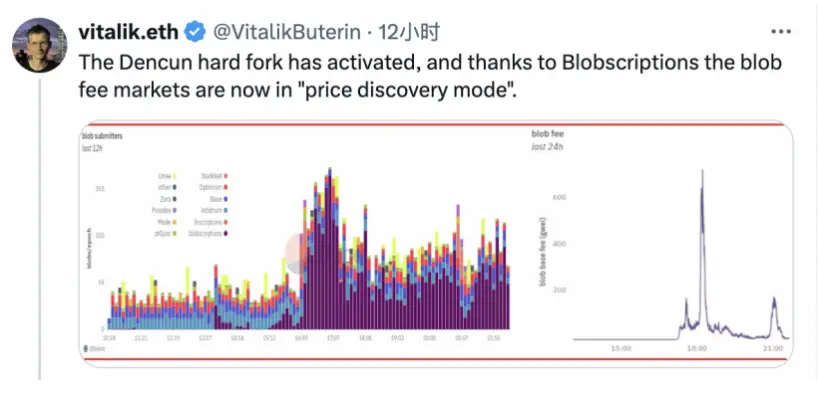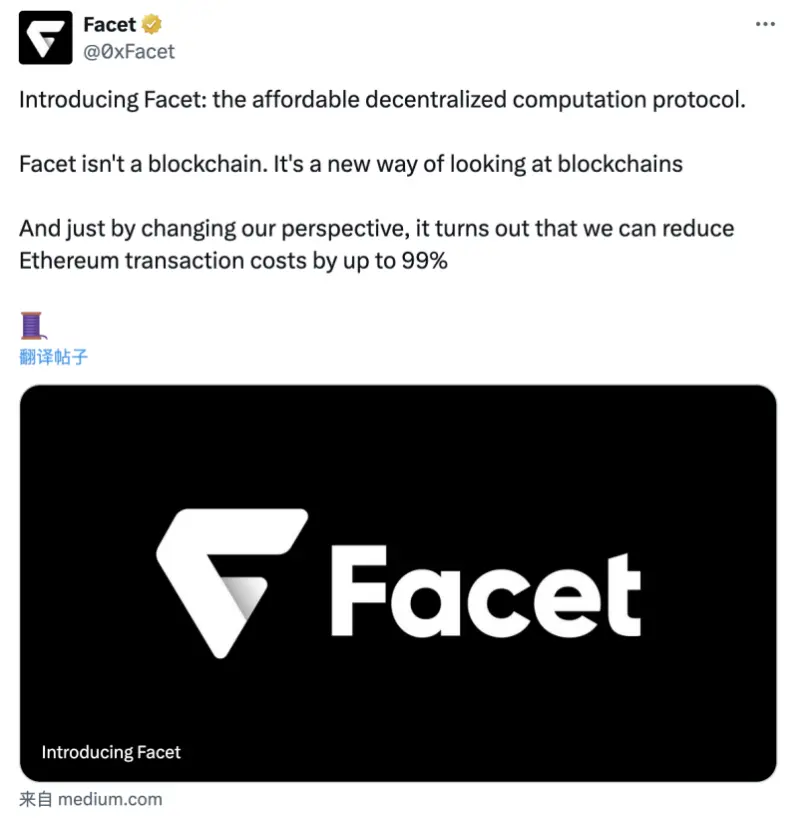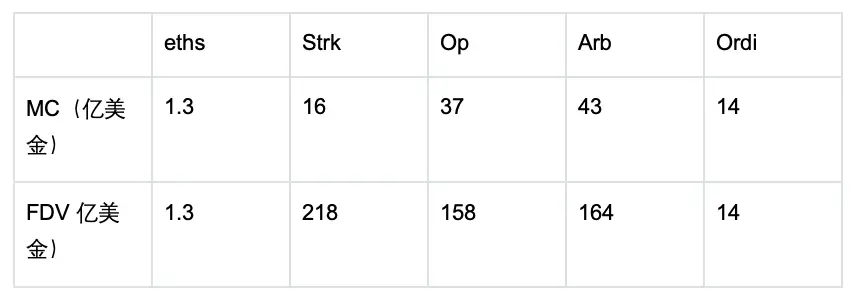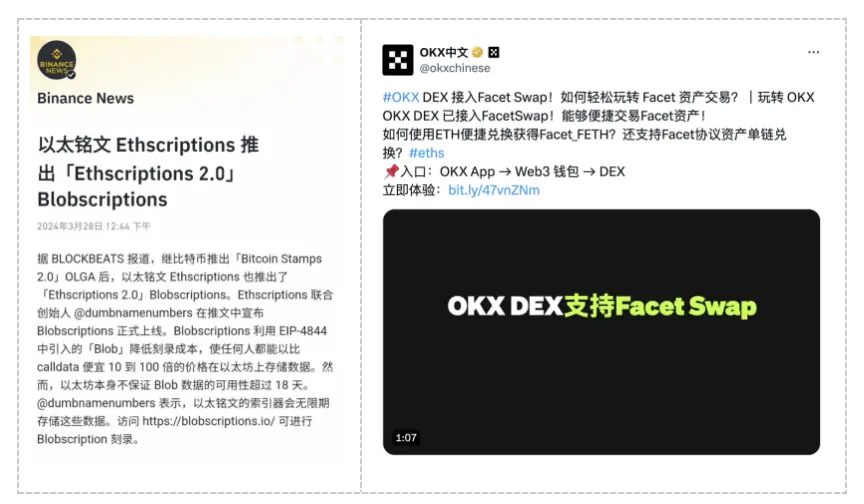How the blobscription mentioned by Vitalik opens up new narrative space for ETHs
Source: Killer Research
On March 28, Vitalik publicly tweeted in support of Ethscription: "The Dencun hard fork has been activated, thanks to Blobscriptions, the blob fee market is now in 'price discovery mode.'"

Blobscriptions is a new feature launched by Ethscription on March 27, which quickly attracted attention from many well-known figures and projects, including Vitalik. Since then, Ethscription has become one of the general scalability solutions that combines off-chain computing capabilities with the legitimacy of the Ethereum ecosystem.
1. Emerging Ethereum Layer 2 ------ Facet
As early as August 2023, Ethscriptions introduced a virtual machine (ESC VM, later renamed Facet VM) to enhance its functionality, theoretically allowing it to become a general-purpose computing engine. On October 7, 2023, Ethscription launched the Dumb Contracts technology, allowing users to share information and execute computations on Ethereum L1 at low cost. It bypasses smart contract storage and execution by applying rules to Ethereum call data, achieving decentralized computing. It can run directly on the mainnet and implement smart contract functionalities while reducing gas fees for on-chain operations.

From this perspective, Ethscription has far surpassed the level of inscriptions, capable of executing more complex contract logic, taking on the mission of scalability for the Ethereum mainnet, and the Ethscription ecosystem is beginning to show great potential. For example, Binance liquidity aggregator Orion announced plans to launch the relayer Scorpio in the Ethscriptions ecosystem, bridging traditional Ethereum ecosystem Dapp applications into the Ethscription system, which will introduce various products such as stablecoin, liquid staking, and cross-chain bridges in the future.
Ethscription has proposed many enhancements for scalability, such as ESIP-4 supporting the deployment and interaction of Dumb Contracts, improving functionality and scalability, and simultaneously launching Dumbswap to support the circulation of tokens like $eths; ESIP-5 supports batch transfers of inscriptions in a single transaction. ESIP-6 proposes a backward-compatible mechanism that allows for the creation and processing of duplicate information in the protocol after the proposal goes live, accommodating more complex contract functionalities and applications in the future. It is evident that all of Ethscription's developments are laying the groundwork for supporting more, stronger, and more complex functionalities and products.
2. New Changes Brought by the Cancun Upgrade ------ Blob
Speaking of Vitalik's endorsement of the new Ethscription feature Blobscriptions, we must first discuss the Ethereum Cancun upgrade.
Various Rollup solutions we are familiar with require uploading data to the Ethereum mainnet as L1 to achieve data availability, necessitating that this data be placed and exist on L1 for everyone to see and verify when challenged. Therefore, the goal is to reduce the cost of this upload.
The Cancun upgrade in March introduced a new transaction type called Blob, which has two characteristics:
- The values inside a Blob cannot be directly read within contracts, as they only need to be stored, not actively read or executed for verification.
- There is a storage duration, currently set at 18 days. The main idea behind this design is that data only needs to be stored long enough for nodes to have sufficient time to synchronize the data, while the task of storing all complete historical data should be left to those interested in that data. Currently, Ethereum's solution is to store it for only 18 days.
Essentially, a Blob can be seen as a temporary storage space that allows Layer 2 transaction data to be moved into a new temporary blob for storage, without actually storing Layer 2 transaction data on Layer 1. This greatly reduces the storage costs for L1 and also facilitates the storage of large volumes of data, achieving scalability. In other words, Rollups need to upload data to L1, which previously relied on calldata. After the Cancun upgrade, Layer 2 Rollup data can be transmitted to Layer 1 in the form of blobs at a lower cost, without needing to be permanently stored like calldata.
After introducing blobs, the next step is to gain consistent support from all clients. Vitalik pointed out in his latest lengthy article "The Evolution of Ethereum: A Sequel" that in the future, blob capacity should be gradually increased, and L2 should be improved to better utilize this data space.

3. The Legitimacy Narrative of the Ethereum Ecosystem DA ------ Blobscriptions
After the Cancun upgrade, there are approximately five main DA projects (data availability projects) on the market:
- The ETH blob/Danksharding we introduced above
- Celestia (independent decentralized DA)
- Near DA
- EigenDA/MantleDA (DA utilizing ETH restaking)
- Centralized DA (Validum model)
In simple terms, data availability refers to the condition where block producers publish all transaction data of a block and ensure that validators can download it without concealment, which requires incurring certain costs. The purpose of DA is to ensure that the verification mechanism operates securely while simultaneously reducing the cost of publishing data. The EIP-4844 upgrade carried out by Ethereum significantly reduced the cost of publishing data for L2 on L1. In the eyes of the Ethereum Foundation and Vitalik, this legitimacy needs to be upheld—meaning that solutions not utilizing Ethereum DA are not true Ethereum Layer 2.
 Ethscription, as one of the first scalability solutions to respond to blobs, not only actively embraces blobs but also designs blobscription as a permanent storage mode. Currently, Layer 2 data charging is relatively opaque, and there may be additional costs incurred during the user's data upload process. If L2 upgrades to the blob model, it may reduce profits in a non-explosive ecological state. Since many Layer 2s may consider cost and profit-related business issues, there may not be immediate motivation for L2 to quickly implement blobs in the short term.
Ethscription, as one of the first scalability solutions to respond to blobs, not only actively embraces blobs but also designs blobscription as a permanent storage mode. Currently, Layer 2 data charging is relatively opaque, and there may be additional costs incurred during the user's data upload process. If L2 upgrades to the blob model, it may reduce profits in a non-explosive ecological state. Since many Layer 2s may consider cost and profit-related business issues, there may not be immediate motivation for L2 to quickly implement blobs in the short term.
The banner of DA legitimacy has been taken up by Ethscription at this moment. As a general-purpose computing engine that has already introduced a virtual machine, Ethscription's position within the Ethereum ecosystem has been elevated once again, further entering the core ecosystem of Ethereum and becoming one of the first typical representatives under the ETH blob/Danksharding camp.
4. Eths Value Assessment
Eths, as the asset with the greatest consensus within the Ethscription system, has now become a symbol of Ethscription. From grassroots emergence to the initial establishment of a community, and then to breaking through the initial meme significance of inscriptions to become an Ethereum Layer 2, Eths has grown into a powerful ecosystem through ups and downs. Compared to the market capitalization of leading inscriptions and other Layer 2s, as the leading asset of the Ethscription ecosystem, Eths currently has a relatively small market capitalization. Vitalik's call to action has further proven that once Eths is discovered for its value, it has strong explosive potential.

It can also be seen that Binance and OKX have continuously expressed interest and attention towards Ethscription, with frequent interactions on official Twitter and active product integrations.

We can expect that Blobscriptions will continue to play a leading role in promoting Ethereum blob/Danksharding, and we can also anticipate that Ethscription will introduce more constructive proposals regarding blobs in the future. Furthermore, we can believe that Ethscription, as one of the projects with the strongest on-chain community, will set a better example for other Layer 2 projects in terms of ecosystem construction and community building. In the future, Ethscription will further grow into an Ethereum scalability solution with official legitimacy, a strong ecosystem, a unified community, and core carrying capacity under the attention and promotion of the Ethereum Foundation/Vitalik.
At the same time, we can further expand the imagination space for the market value of Eths as the leading token of Ethscription. Currently, Eths has not yet been listed on top-tier exchanges, but its daily trading volume of tens of millions of dollars on second-tier exchanges and its on-chain ecosystem have already proven its strong vitality. Eths is still in the early stages of value discovery, and the popularity of Blobscriptions is merely the market's initial feedback on the value discovery of Ethscription.











